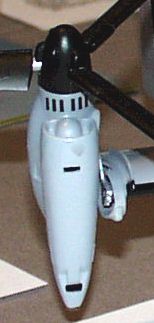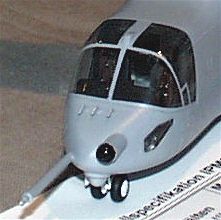text by Martin Waligorski
photo by Peter Alsterberg
Italeri has a tradition of pleasing us with many fine kits of contemporary rotorcraft, and this one is no exception. Björn Ringholm utilised the Italeri kit to built this 1/72 model of V-22 Osprey.
rotorcraft, and this one is no exception. Björn Ringholm utilised the Italeri kit to built this 1/72 model of V-22 Osprey.
The V-22
The Osprey is as unconventional as it is revolutionary. It combines the vertical take-off characteristics of the helicopter with (relatively) high speed of the conventional aircraft. The tilt-rotor design combines the vertical flight capabilities of a helicopter with the speed and range of a turboprop airplane and permits aerial refuelling.
Two 6150 horsepower turboshaft engines each drive a 38 feet diameter, 3-bladed propeller/rotor. The rotors are connected to each other by interconnect shafting which maintains synchronisation and provides single engine power to both rotors in the event of an engine failure.
Currently the V-22 is still undergoing the final development, and the production lines are being established. The deliveries of series machines are expected to commence in 2001.
The primary user of the type is bound to be US Marine Corps. The Osprey will replace assault helicopters in the medium lift category (CH-46E and CH-53D), contributing to the larger mobility of the Marine landing force.
Compared to an average helicopter, the Osprey offers five times the range, up to three times more cargo, and double the top speed.
The project
Björn used the Italeri kit for ”warming up” before the planned construction  of Italeri’s 1/48th scale Osprey. By the way, the two kits appear to be identical – one is a direct downsize of the other – or is it the other way around… Anyway, the kit was quite nice with fine raised surface detail.
of Italeri’s 1/48th scale Osprey. By the way, the two kits appear to be identical – one is a direct downsize of the other – or is it the other way around… Anyway, the kit was quite nice with fine raised surface detail.
Björn built it almost out-of-the-box. The construction was not without a few fit problems so filler was necessary, especially at the wing-to-fuselage joint. The raised panel lines sanded away in the process were restored by carefully gluing fine lengths of stretched sprue over the model.
Putting enough weight in the nose to prevent tail-sitting proved to be almost impossible due to the limited space in the fuselage. Björn reverted to opening the rear cargo door to solve the problem, which also had a benefit of adding interest to the finished model.
Björn produced the overall grey finish by airbrushing three different grey shades of Gunze Acrylics. Tamiya X18 Semi-Gloss Black was used for black areas like rotors and wing leading edges. Exposed hydraulic parts were clad with Bare Metal Foil for that realistic metallic look.
The model represents one of the early prototypes, which didn’t carry any markings.
The model won the ”unmodified” small-scale rotorcraft class at the IPMS Open 1999.
This article was originally published in IPMS Stockholm Magazine in September 1999.
